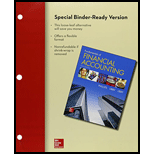
Loose-leaf for Fundamentals of Financial Accounting with Connect
5th Edition
ISBN: 9781259619007
Author: Fred Phillips Associate Professor
Publisher: McGraw-Hill Education
expand_more
expand_more
format_list_bulleted
Concept explainers
Textbook Question
Chapter 8, Problem 8.7E
Computing
Brown Cow Dairy uses the aging approach to estimate Bad Debt Expense. The balance of each account receivable is aged on the basis of three time periods as follows: (1 ) 1–30 days old, $12,000; (2) 31–90 days old, $5,000; and (3) more than 90 days old, $3,000. Experience has shown that for each age group, the average loss rate on the amount of the receivable due to uncollectibility is (1) 5 percent, (2) 10 percent, and (3) 20 percent, respectively. At December 31 (end of the current year), the Allowance for Doubtful Accounts balance was $800 (credit) before the end-of-period
Required:
- 1. Prepare a schedule to estimate an appropriate year-end balance for the Allowance for Doubtful Accounts.
- 2. What amount of Bad Debt Expense should be recorded on December 31?
- 3. If the unadjusted balance in the Allowance for Doubtful Accounts was a $600 debit balance, what amount of Bad Debt Expense should be recorded on December 31?
Expert Solution & Answer
Want to see the full answer?
Check out a sample textbook solution
Students have asked these similar questions
Need General Accounting Question Solution Provide answer if you sure otherwise don't
Provide Correct Answer of this One Without Any error General Accounting Question Solution
hi teacher please help me with General accounting question
Chapter 8 Solutions
Loose-leaf for Fundamentals of Financial Accounting with Connect
Ch. 8 - What are the advantages and disadvantages of...Ch. 8 - Prob. 2QCh. 8 - Which basic accounting principles does the...Ch. 8 - Using the allowance method, is Bad Debt Expense...Ch. 8 - What is the effect of the write-off of...Ch. 8 - How does the use of calculated estimates differ...Ch. 8 - Prob. 7QCh. 8 - What is the primary difference between accounts...Ch. 8 - What are the three components of the interest...Ch. 8 - Prob. 10Q
Ch. 8 - Does an increase in the receivables turnover ratio...Ch. 8 - What two approaches can managers take to speed up...Ch. 8 - When customers experience economic difficulties,...Ch. 8 - (Supplement 8A) Describe how (and when) the direct...Ch. 8 - (Supplement 8A) Refer to question 7. What amounts...Ch. 8 - 1. When a company using the allowance method...Ch. 8 - 2. When using the allowance method, as Bad Debt...Ch. 8 - 3. For many years, Carefree Company has estimated...Ch. 8 - 4. Which of the following best describes the...Ch. 8 - 5. If the Allowance for Doubtful Accounts opened...Ch. 8 - 6. When an account receivable is recovered a....Ch. 8 - Prob. 7MCCh. 8 - 8. If the receivables turnover ratio decreased...Ch. 8 - Prob. 9MCCh. 8 - Prob. 10MCCh. 8 - Prob. 8.1MECh. 8 - Evaluating the Decision to Extend Credit Last...Ch. 8 - Prob. 8.3MECh. 8 - Prob. 8.4MECh. 8 - Recording Write-Offs and Bad Debt Expense Using...Ch. 8 - Determining Financial Statement Effects of...Ch. 8 - Estimating Bad Debts Using the Percentage of...Ch. 8 - Estimating Bad Debts Using the Aging Method Assume...Ch. 8 - Recording Bad Debt Estimates Using the Two...Ch. 8 - Prob. 8.10MECh. 8 - Prob. 8.11MECh. 8 - Recording Note Receivable Transactions RecRoom...Ch. 8 - Prob. 8.13MECh. 8 - Determining the Effects of Credit Policy Changes...Ch. 8 - Prob. 8.15MECh. 8 - (Supplement 8A) Recording Write-Offs and Reporting...Ch. 8 - Recording Bad Debt Expense Estimates and...Ch. 8 - Determining Financial Statement Effects of Bad...Ch. 8 - Recording, Reporting, and Evaluating a Bad Debt...Ch. 8 - Recording Write-Offs and Recoveries Prior to...Ch. 8 - Prob. 8.5ECh. 8 - Computing Bad Debt Expense Using Aging of Accounts...Ch. 8 - Computing Bad Debt Expense Using Aging of Accounts...Ch. 8 - Recording and Reporting Allowance for Doubtful...Ch. 8 - Recording and Determining the Effects of Write-Off...Ch. 8 - Prob. 8.10ECh. 8 - Recording Note Receivable Transactions, Including...Ch. 8 - Recording Note Receivable Transactions, Including...Ch. 8 - Prob. 8.13ECh. 8 - Prob. 8.14ECh. 8 - Prob. 8.15ECh. 8 - Prob. 8.16ECh. 8 - (Supplement 8A) Recording Write-Offs and Reporting...Ch. 8 - Recording Accounts Receivable Transactions Using...Ch. 8 - Prob. 8.2CPCh. 8 - Recording Notes Receivable Transactions Jung ...Ch. 8 - Accounting for Accounts and Notes Receivable...Ch. 8 - Prob. 8.5CPCh. 8 - Recording Accounts Receivable Transactions Using...Ch. 8 - Prob. 8.2PACh. 8 - Prob. 8.3PACh. 8 - Accounting for Accounts and Notes Receivable...Ch. 8 - Analyzing Allowance for Doubtful Accounts,...Ch. 8 - Recording Accounts Receivable Transactions Using...Ch. 8 - Interpreting Disclosure of Allowance for Doubtful...Ch. 8 - Recording Notes Receivable Transactions Stinson...Ch. 8 - Accounting for Accounts and Notes Receivable...Ch. 8 - Prob. 8.5PBCh. 8 - Recording and Reporting Credit Sales and Bad Debts...Ch. 8 - Prob. 8.2COPCh. 8 - Recording Daily and Adjusting Entries Using FIFO...Ch. 8 - Prob. 8.1SDCCh. 8 - Comparing Financial Information Refer to the...Ch. 8 - Ethical Decision Making: A Real-Life Example You...Ch. 8 - Critical Thinking: Analyzing the Impact of Credit...Ch. 8 - Using an Aging Schedule to Estimate Bad Debts and...Ch. 8 - Accounting for Receivables and Uncollectible...
Knowledge Booster
Learn more about
Need a deep-dive on the concept behind this application? Look no further. Learn more about this topic, accounting and related others by exploring similar questions and additional content below.Similar questions
arrow_back_ios
SEE MORE QUESTIONS
arrow_forward_ios
Recommended textbooks for you
 Cornerstones of Financial AccountingAccountingISBN:9781337690881Author:Jay Rich, Jeff JonesPublisher:Cengage Learning
Cornerstones of Financial AccountingAccountingISBN:9781337690881Author:Jay Rich, Jeff JonesPublisher:Cengage Learning College Accounting, Chapters 1-27AccountingISBN:9781337794756Author:HEINTZ, James A.Publisher:Cengage Learning,
College Accounting, Chapters 1-27AccountingISBN:9781337794756Author:HEINTZ, James A.Publisher:Cengage Learning,

Cornerstones of Financial Accounting
Accounting
ISBN:9781337690881
Author:Jay Rich, Jeff Jones
Publisher:Cengage Learning


College Accounting, Chapters 1-27
Accounting
ISBN:9781337794756
Author:HEINTZ, James A.
Publisher:Cengage Learning,
Accounts Receivable and Accounts Payable; Author: The Finance Storyteller;https://www.youtube.com/watch?v=x_aUWbQa878;License: Standard Youtube License